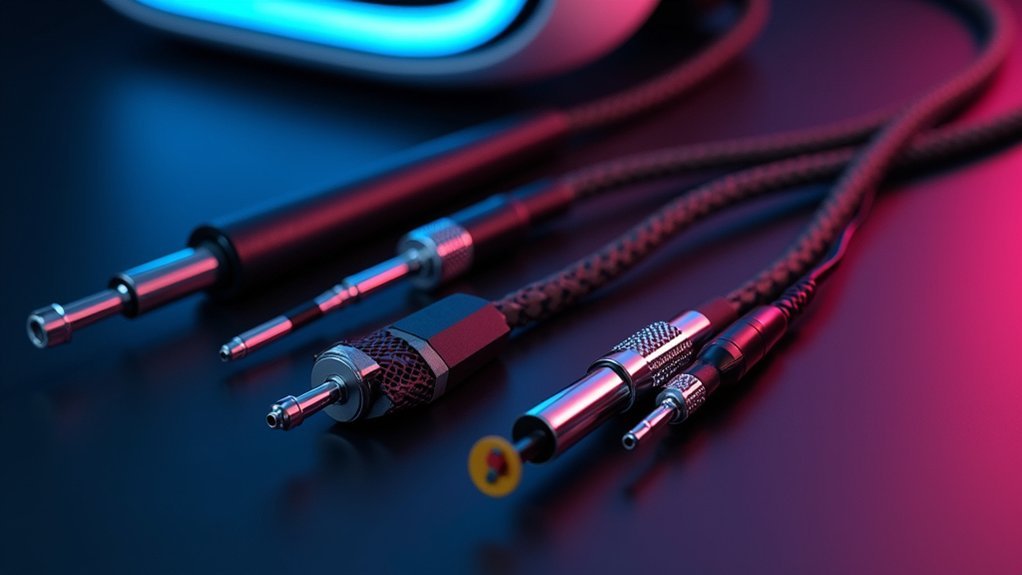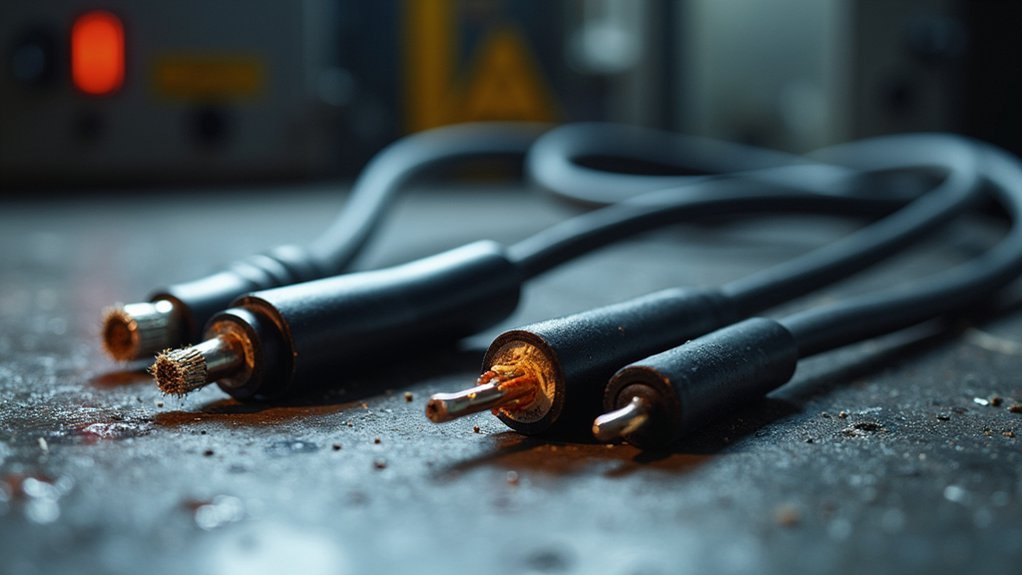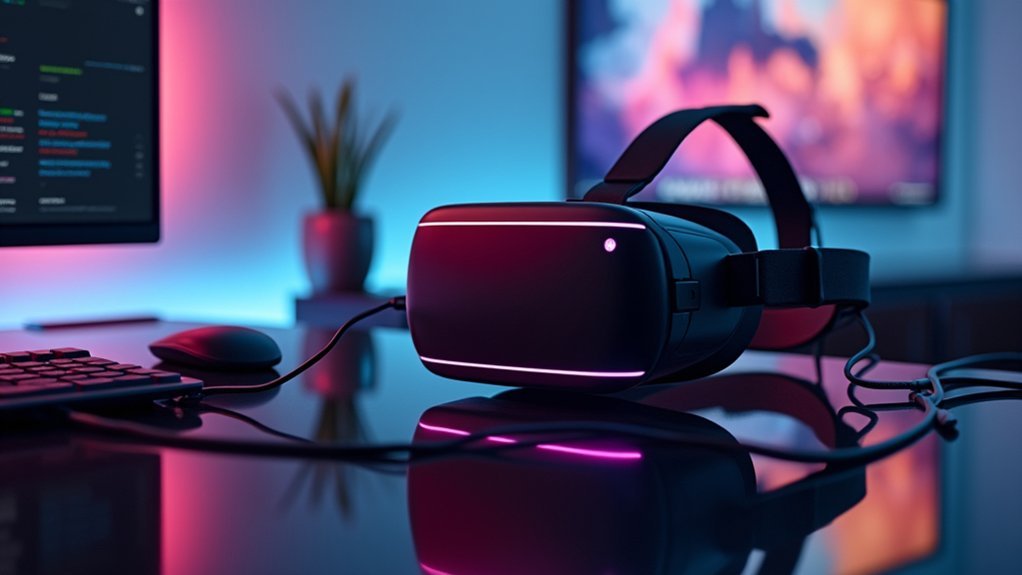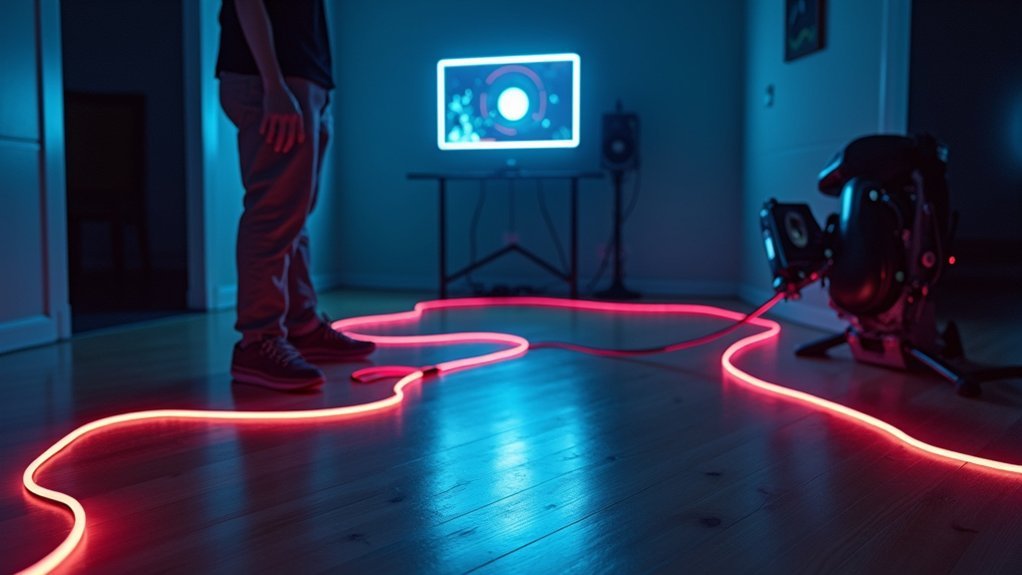You’ll need a USB 3.0 link cable that’s at least 16 feet long with an L-shaped connector for ideal VR performance. Look for cables like the Syntech 2-In-1 or KIWI Design that support 5Gbps data transfer and withstand over 5,000 bends. The L-shaped design prevents disconnections during intense gameplay while longer lengths provide room-scale movement freedom. These specifications guarantee smooth data transfer, reliable charging, and durability for extended sessions. The complete cable selection process involves several additional technical considerations.
Essential Cable Specifications for Optimal VR Performance

When choosing a VR cable, you’ll need to prioritize USB 3.0 or higher connectivity to achieve the essential 5Gbps data transfer speed that prevents lag and maintains smooth gameplay.
Your Oculus Quest requires fast data transfer to deliver peak performance during intensive gaming sessions.
Fast data transfer ensures your Oculus Quest maintains peak performance during the most demanding VR gaming sessions.
Cable length matters considerably for movement freedom. You’ll want at least 10 feet to avoid restrictions, though 20-foot options work better for larger spaces.
An L-shaped connector design prevents accidental disconnections while reducing cable stress during use.
Durability specifications should include resistance to at least 5,000 bends using premium materials that won’t fray over time.
Your USB C cable should also feature charging capabilities to maintain battery levels during extended play.
These combined specifications guarantee your VR link cable delivers reliable, uninterrupted performance.
Top-Rated Link Cable Options for Quest and Pico Headsets
Now that you understand what specifications to look for, let’s examine the best link cables currently available for your Quest or Pico headset.
The Syntech VR Headset Fast Link Cable delivers exceptional performance with its 16-foot length and built-in USB-C cable for simultaneous charging.
For durability, the Syntech 2-In-1 Link Cable withstands 5,000 bends and features an L-shaped connector for stable connections across Quest 3, Quest 2, Quest Pro, and Pico 4 models.
The CableCreation option excels in fast data transfer at 5Gbps with 2A charging capabilities.
Meanwhile, KIWI Design’s lightweight, flexible design minimizes drag during your VR experience.
Each durable option enhances your VR headset’s performance while providing reliable charging cables for extended gaming sessions.
Durability Testing and Long-Term Reliability Features

Although choosing a link cable with impressive specifications matters, understanding its durability testing and long-term reliability features guarantees you’re making a smart investment for years of VR gaming.
Understanding durability testing and long-term reliability features ensures your VR link cable investment delivers consistent performance for years of gaming.
Top-tier VR link cables undergo rigorous testing, with models like the KIWI Design surviving over 5,000 insertion cycles. High-quality materials enable cables like the Syntech 2-In-1 to withstand 5,000 bends without performance degradation.
Reinforced connectors with L-shaped designs prevent accidental disconnections during intense gameplay sessions. Cables supporting 5Gbps data transfer maintain signal integrity over extended distances, reducing internal wear.
Cable management features like Velcro straps prevent tangling and damage, greatly improving longevity. These durability factors ensure your investment delivers consistent performance throughout countless VR adventures.
Cable Length and Movement Freedom Considerations
Since movement freedom directly impacts your VR immersion, selecting the right cable length becomes essential for releasing your headset’s full potential.
You’ll want at least 16 feet for adequate movement freedom during VR gameplay, though longer cables measuring 20 feet provide enhanced room-scale experiences.
Flexible designs minimize drag and discomfort, allowing you to engage in extended VR sessions without restriction.
Right angle connectors prevent disconnections while reducing cable bending that could limit your movements.
Lightweight cables decrease fatigue during use, making immersive gameplay more enjoyable without heavy equipment weighing you down.
These cable considerations directly影响 your ability to move naturally, ensuring you can fully explore virtual worlds without constantly worrying about cable limitations interrupting your experience.
USB-C Compatibility and Power Management Solutions

How do you guarantee your VR headset receives consistent power and data transmission through USB-C connections?
You’ll need USB 3.0 or higher cables with minimum 5Gbps bandwidth for effective data transfer in VR applications. Choose expansion cards carefully, as many deliver inconsistent power management during simultaneous charging and data transmission.
Improve connection reliability by disabling power-saving features for USB ports in Windows device manager settings.
L-shaped USB-C connectors enhance stability and prevent accidental disconnections during intense gameplay sessions. For Oculus Link setups requiring longer distances, active extension cables maintain performance but need proper power supply to function effectively.
Select quality USB-C hardware specifically designed for VR applications to avoid frustrating interruptions.
Proper power management guarantees your headset stays charged while maintaining peak data transfer rates throughout extended gaming sessions.
Frequently Asked Questions
What Is the Best Cable for VR?
You’ll want KIWI Design Link Cables for their lightweight, flexible design and secure L-shaped connector. They’re tested for 5,000+ insertions and won’t accidentally disconnect during your VR sessions.
What Cable Can I Use Instead of Oculus Link?
You can use the Syntech 2-In-1 Link Cable or Anker USB-C to USB 3.1 cable instead of Oculus Link. Both support USB 3.0+ with 5Gbps speeds for smooth VR gameplay.
Will Any Cable Work for Oculus Link?
Not all cables will work for Oculus Link. You’ll need a USB 3.0 or higher cable with 5Gbps minimum bandwidth. Many standard USB-C cables don’t meet these requirements, so you can’t use just any cable.
Is Air Link or Link Cable Better?
You’ll get better performance with Link Cable since it provides stable 5Gbps speeds and charges while playing. Air Link’s convenient but suffers from Wi-Fi latency issues and battery drain.
In Summary
You’ll find that the right VR cable dramatically impacts your gaming experience. Focus on USB-C cables with high data transfer rates and sufficient power delivery for your Quest or Pico headset. Don’t compromise on build quality—invest in cables with reinforced connectors and flexible shielding. Consider your play space when choosing length, and always verify compatibility with your specific headset model. The perfect cable balances performance, durability, and freedom of movement for immersive VR sessions.





Leave a Reply